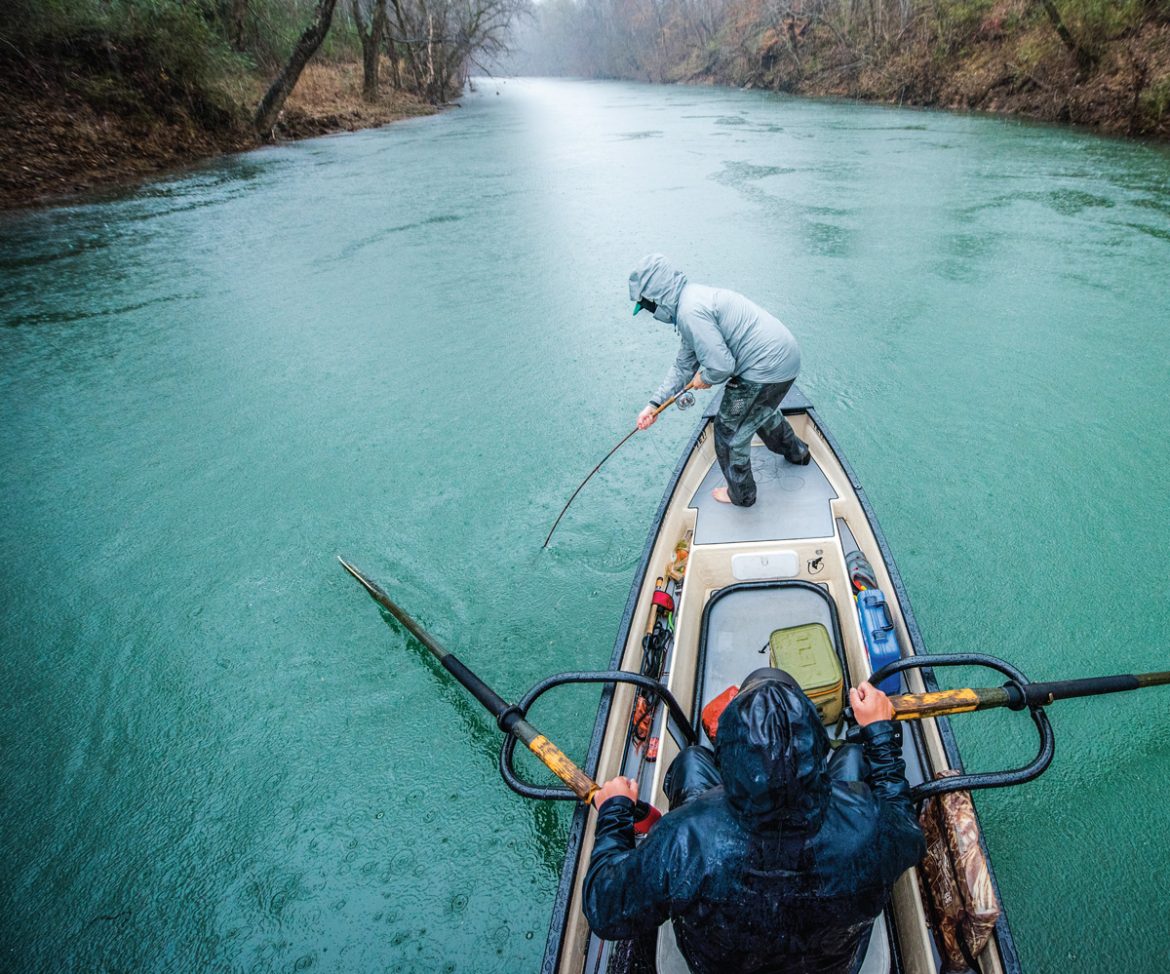
When, where, and how to increase your odds of hooking one of the sport’s most sought-after game fish.
[By Robert Tomes]AS ONE OF NORTH AMERICA’S LARGEST AND PREMIER FRESHWATER GAME FISH, the elusive nature of the muskie has spawned a boat load of myths and legends—and even a few liars.
Most misconceptions have to do with its reptilian looks and large size, savage strikes, and much-heralded reputation as the “fish of 10,000 casts.” Just as many relate to a muskie’s confounding moodiness and propensity to “follow” a fly or lure instead of striking. Why a ferocious apex predator like the muskie exhibits these cautious behaviors is one of the great mysteries of fishing. Taken together, these myths and legends make the emerging sport of muskie fly fishing both highly addictive and (on certain days) equally frustrating.
Fishing folklore aside, I have found several fall patterns and triggers over my several decades of pursuing muskies on the fly that, while admittedly unscientific, seem to tip the balance in an angler’s favor when chasing this amazing game fish. That said, here are a few thoughts on when, where, and how you can up the odds of landing one of these brutish fish this fall.

The Supermoon
The fall of 2016 included one of the great astronomical events of our lifetime—the super full moon. This rare event happened on November 14, 2016, when a full moon appeared at exactly the same time as its closest approach, or perigee, to Earth. During that astronomical “drive by,” the moon looked much larger and brighter compared to an average full moon, and it had a corresponding increased gravitational pull on the earth’s surface, especially noticeable with the ocean tides. More important, at least for hunters and anglers, many believe the moon’s supersized gravitational pull causes big changes in human and animal behavior, including that of muskies. And despite the dreaded “curse of the full moon” for many predatory fish species, this was a celestial event that promised amazing fishing, day or night.
Armed with this knowledge, I set out on a popular Midwest muskie flowage the same day as the super full moon with my friend and guide Jay Anglin of Anglin Outdoors (www.anglinoutdoors.com) to take advantage of what was probably a once-in-a-lifetime opportunity. (The last major super full moon happened way back in 1948, and the next major event won’t happen again until November 25, 2034.) Our confidence was higher than usual, given what we knew what was happening in the sky above us. But after a few long hours of hitting different hot spots with no action to speak of, we started questioning our mutual sanity and gullibility regarding the old wives’ tale.
With only a few hours of daylight remaining, we decided to hit one last cabbage bed that, to our surprise, still supported some green weeds. My first cast with a perch-colored, synthetic streamer pattern brought the first muskie follow of the day. Two casts later, we had our first fish of the trip, a fat 36-inch-long muskie that was obviously eating well. But what followed that encounter was amazing by any muskie-fishing standards. Jay and I tallied 30 follows and six fish landed and released, all on a fly, in a two-hour window before sunset.
Was our outrageous good fortune because of the super full moon? Hindsight is always 20/20, but given the intensity of the bite that great November day, and the number of fish seen and landed, we both concluded it must’ve had something to do with our success—or luck.
Many Moons
As the most visible object in the night sky, a full moon has captured man’s attention and imagination for centuries. Its bright light and predictable monthly cycle has led to numerous legends and folktales among the world’s varied cultures, mostly as a luminous omen of good (or bad) weather, harvest, and luck.
Although some full-moon names stem from ancient times, Native Americans created many of the common full-moon names used today. As you might expect, most of the summer and fall full moons carry names associated with agriculture, hunting, and fishing. Hence, we have the “buck” full moon in July, when the deer are in velvet and the “hunter’s” full moon in October when hunting season is under way. So far, the August “sturgeon” full moon remains the only name associated with a fish. Based on the productive late-season muskie bite, perhaps it’s time we started calling the full moon of either October, November, or December the “Muskie Moon”? To make the most of your future muskie fishing, here’s a complete list of the remaining full-moon dates in 2017 and 2018, along with the related name.
2018
January 1 / Wolf Moon
January 31 / Wolf/Blue Moon
March 1 / Worm Moon
March 31 / Worm/Blue Moon
April 29 / Pink Moon
May 29 / Flower Moon
June 27 / Strawberry Moon
July 27 / Buck Moon
August 26 / Sturgeon Moon
September 24 / Harvest Moon
October 24 / Hunter’s Moon
November 22 / Beaver Moon
December 22 / Cold Moon
More important than that once-in-a-lifetime event, there’s no doubt in many die-hard muskie anglers’ minds that even a normal new- and full-moon event plays a critical part in angling success, especially with big fish. Over the years, almost all the giant muskies and records I’ve caught on a fly have come during a new- or full-moon phase, give or take a few days on either side. Among professional muskie guides I know and fish with around North America, the late-season “muskie moon” effect is so powerful that nearly everyone reserves the days for their best clients and set their watches for the critical moonrise and -set in anticipation of catching a trophy.
Fortunately for muskie fly fishers, the moon completes an elliptical orbit around the earth roughly every 28 days, providing ample opportunity to fish a full and new muskie-moon phase throughout the season. And for those fly rod muskie fanatics who can’t wait until 2034—and are lucky enough to fish where the muskie season remains open in December—there’s yet another, albeit smaller, supermoon event on December 3, 2017, that may well be the trigger that turns a giant muskie from a follower to a eater!






